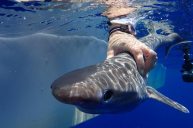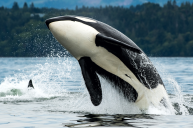A group of scientists studying contaminants in ocean water say that sharks off the coast of Rio de Janeiro tested positive for cocaine. According to the research paper, published on Tuesday in the Science of the Total Environment, found the presence of the drug in more than a dozen sharp nose sharks.
In a statement, Enrico Mendes Saggioro, a pharmacist and co-author of the study, explained that it's routine to test for an assortment of substances and diseases in water and land that could harm humans. Plus, other animals tested positive for coke in the past. "In Brazil, studies have already detected cocaine contamination in water and a few aquatic creatures, such as mussels. Our analysis is the first to find the substance in sharks," Saggioro said.
Drugs in the sewage
Citing research from the 2024 World Drug Report, researchers say the United Nations listed Brazil among the largest global consumers of cocaine. According to the study, the data brings attention to the large amount of drugs consumed in the city and then dumped into the sea via sewage.
Saggioro explained that because of those findings, they decided to add cocaine to the list of contaminants to study. "We found the substance in all 13 sharks analyzed and in only one of them was benzoylecgonine not detected, which is the main metabolite of the drug," Saggioro said.
For the drug tests, Saggioro explained that they analyzed sharks' muscle tissue and livers. They found benzoylecgonine in 12 muscle samples and two liver samples. In turn, they found that the average cocaine concentration in the animals was three times higher than the metabolite concentration. That means that the animals were likely overexposed to the drug.
"To our surprise, cocaine was found in greater concentration in the muscle, which is a tissue where it accumulates, which could indicate the abundance of the substance in the marine environment," Saggioro said. He added, "Just like in humans, the shark's liver is a metabolic organ. Everything that is ingested is transformed by the liver and then excreted."

Researchers provided a graph showing how drugs get into the water. Credit: The Brazilian sharp nose shark measures about 30 inches long. It primarily swims in waters near Brazil. Credit: Oswaldo Cruz Institute
How do sharks do cocaine?
Now, you might be imagining a shark cutting up a line of powder on a mirror and then snorting it with a rolled-up dollar bill. While drugs enter the natural environment through sewage, researchers don't know how it gets into sharks. "Sharks could be becoming contaminated in several ways, either by living in the region or by feeding on other contaminated animals," Enrico added.
Rachel Ann Hauser-Davis, a biologist and co-author, also called them "unprecedented." She said sharks play a crucial role in the marine ecosystem. As predators, they play a central role in the food chain. But also researchers say they are a "sentinel species" to detect environmental damage.
"Specific studies are needed to determine the exact consequences of this contamination on the animals. It is believed that there may be an impact on the growth, maturation and, potentially, fertility of sharks, since the liver plays a role in the development of embryos," Rachel said.
Although cocaine contaminates Brazil's ocean water and sea life ingests it, researchers don't know the full extent of the consequences. "Pollution and contamination of the environment directly affect animals and nature, but they also impact human life in one way or another. The health of one is linked to the health of the other," Rachel said.




